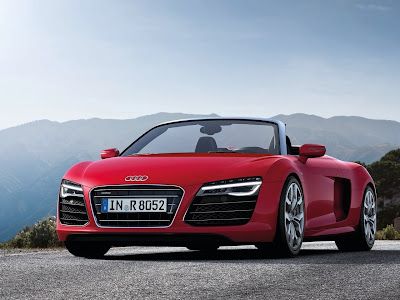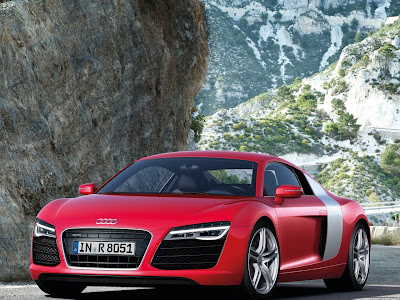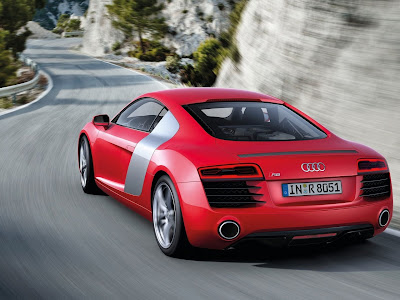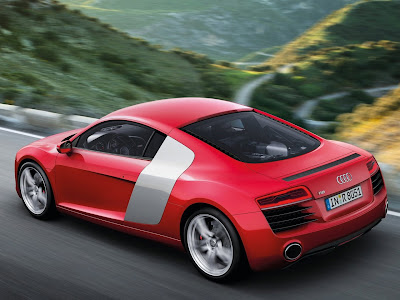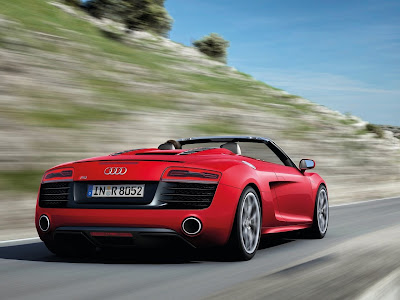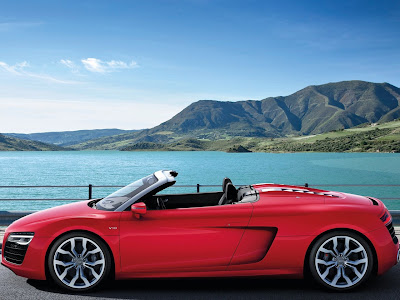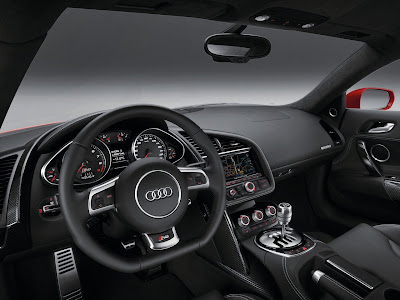The Audi R8 is the sporty spearhead of the Audi model lineup. Now the high-performance sports car is more dynamic than ever, with the S tronic transmission and new features on the exterior, in the cabin and for the brakes. All models now come standard with all-LED headlights. The rear lights mark the premiere of another dynamic innovation: dynamic turn signals. The powerful new Audi R8 V10 plus with 404 kW (550 hp) sprints from zero to 100 km/h (62.14 mph) in 3.5 seconds. Thanks to Audi ultra lightweight construction, the top-of-the-line model with a manual transmission has a curb weight of just 1,570 kilograms (3,461.26 lb).
Audi R8 V10 Spyder
The reshuffled Audi R8 lineup comprises two body styles - Coupé and Spyder - and three engines. The standard sprint times for both models equipped with the new seven-speed S tronic have improved by 0.3 seconds while fuel consumption has been reduced by as much as 0.9 liters per 100 km (22 grams CO2 per km [35.41 g/mile]).
The eight-cylinder engine powering the Audi R8 V8 delivers 316 kW (430 hp) and 430 Nm (317.15 lb-ft) of torque, the latter between 4,500 and 6,000 rpm. In combination with the seven-speed S tronic, it accelerates the R8 Coupé from zero to 100 km/h (62.14 mph) in 4.3 seconds on its way to a top speed of 300 km/h (186.41 mph). The Audi R8 V10 with the S tronic completes the standard sprint in 3.6 seconds and has a top speed of 314 km/h (195.11 mph). The ten-cylinder engine produces 386 kW (525 hp) and delivers 530 Nm (390.91 lb-ft) of torque to the crankshaft at 6,500 rpm.
At the top of the model range is the new Audi R8 V10 plus with 404 kW (550 hp) and 540 Nm (398.28 lb-ft) of torque. Equipped with the S tronic, it accelerates from zero to 100 km/h (62.14 mph) in 3.5 seconds and reaches a top speed of 317 km/h (196.97 mph). The new top model is only available as a Coupé.
Besides the six-speed manual, the new seven-speed S tronic, which replaces the R tronic used previously, is also available. It is standard in all V10 models. The fast-shifting dual-clutch transmission features a launch control function that provides optimal traction when starting. Power is delivered to the road via the quattro permanent all-wheel drive system with a rear-axle bias.
All versions of the Audi R8 feature an axle load distribution of roughly 43:57 - ideal for a mid-engine sports car. Dry sump lubrication enables the engines to be mounted low, giving the vehicle a very low center of gravity. All of the wheels are mounted on aluminum double wishbones. The setup is tuned for high dynamics, yet delivers good comfort. The adaptive damping system Audi magnetic ride (standard in the R8 V10) adapts the response of the shock absorbers to the requirements of the driver and the road. The chassis of the Audi R8 V10 is decidedly tuned for dynamics. A special configuration including modified spring/damper tuning with a corresponding adjustment of the camber values at the front axle provides for even more dynamic handling.
The alloy wheels, which measure 18 or 19 inches in diameter depending on the engine, come in a variety of new designs. The brakes are incredibly powerful. All four discs are internally vented and perforated, and their wave design reduces the weight. Audi also offers optional carbon fiber-ceramic discs that are even lighter, yet extremely durable and long-lasting. These are standard with the Audi R8 V10 plus.
ultra lightweight construction: base vehicle weight of 1,560 kilograms (3,439.21 lb)
Audi is demonstrating its expertise in ultra lightweight construction technology with the updated R8. The Audi R8 V8 with the six-speed manual gearbox (without a driver) tips the scales at just 1,560 kilograms (3,439.21 lb); the R8 V10 plus with the manual transmission weighs 1,570 kilograms (3,461.26). The Audi engineers have reduced the weight of the top model by roughly 50 kilograms (110.23 lb).
The most important component in the ultra lightweight construction concept of the Audi R8 is the body. An aluminum Audi Space Frame, it weighs just 210 kilograms (462.97 lb), roughly 40 percent less than a comparable steel structure. The body of the R8 Spyder with its electrohydraulically actuated cloth top weighs 216 kilograms (476.20 lb). The ASF body lays the foundation for the dynamic, precise and safe handling and high passive safety.
The exterior design has been honed ever further. The restructured all-LED headlights and rear lights are standard with all models. The Singleframe grille with tapered corners at the top, the redesigned diffuser and the large, round tailpipes are the most eye-catching new features. The diffuser of the Audi R8 V10 plus features a different geometry and is made of carbon fiber-reinforced polymer. The rear lights of all models include dynamic turn signals, a worldwide first from Audi. Produced by LEDs, the turn signal runs from the inside out in the direction in which the driver wants to turn.
Many bolt-on body parts of the R8 Spyder and R8 V10 plus are made of carbon fiber-reinforced polymer (CFRP). The same material is also used in the interior of the top model. The driver and passenger sit in bucket seats with folding backrests. The interior of all versions of the high-performance sports car is now even more refined. With the honeycomb-quilted Fine Nappa full-leather package, the seat covers and inserts in the door liners are quilted. This quilting is also available as an option for the Alcantara headlining.
The updated Audi R8, which is built in a quattro GmbH factory in Neckarsulm, is scheduled to launch in Europe toward the end of 2012. The base price in Germany is €113,500.
Exterior design
One glance is all it takes to recognize the Audi R8 as the brand's dynamic spearhead. 4.44 meters (14.57 ft) long, 1.90 meters (6.23 ft) wide and just 1.25 meters (4.10 ft) tall (Spyder: 1.24 meters [4.07 ft]), it has a wide, hunkered down road stance. Sharp lines frame sculpturally arched surfaces; new details give the high-performance sports car an even sharper, more distinctive look.
A wrap-around contour called the loop visually connects the front, the wheel wells, the flanks and the rear of the Audi R8. The cabin located far to the front visualizes the mid-engine concept. With the Coupé, the upright air intakes in front of the rear wheels - the sideblades - are also indicative of the position of the engine. The right sideblade includes the solid aluminum gas cap. Rather than the sideblades, the R8 Spyder has large air intakes athletically sculpted out of the flanks.
At the front of the car, the new Singleframe grille with the tapered top corners catches the eye. It is finished in high-gloss black; in V10 models, its struts are adorned with fine chrome strips. The four Audi rings are not on the grille, but on the hood.
The bumper has also been redesigned. In all Audi R8 models, the black air intakes that direct air to the radiator and the brakes have three crossbars.
Audi offers an optional front splitter made of carbon fiber-reinforced polymer (CFRP). The splitter is standard with the new R8 V10. The matt Titanium Gray air intakes and subtle modifications to the Singleframe grille clearly signify the special position occupied by the top model.
All versions of the high-performance sports car now come standard with all-LED headlights, a technology that Audi introduced with the Audi R8 four years ago before any other car maker in the world. Their configuration is new - a special control unit transforms the strip-like daytime running lights into turn signals. The LEDs for the high and low beams are located above and below the daytime running lights. The headlights also include a static turning light.
The all-LED headlights not only look dynamic, they also offer superior performance. At 5,500 Kelvin, their light has a color temperature similar to daylight, making it less fatiguing for the eyes while driving at night. The LED headlights feature excellent light distribution and a virtually infinite service life.
Differentiation: mirrors, sideblades and sills
The sleek contour of the exterior mirrors offers the slipstream little resistance. With the R8 V10, the housings of the exterior mirrors are made of CFRP. The V8 and V10 versions of the Coupé are distinguished by the design of the sideblades. They are flared wider on the ten-cylinder model and have unique edges. The sideblades of the Audi R8 V10 plus are made of CFRP. There are also differences between the side sills of the eight and ten-cylinder versions.
The windshield frame of the R8 Spyder is coated with anodized aluminum. Two large cowls in shining silver run from the bulkhead to the rear of the car. Integrated into these are upright air intakes. Another wide discharge vent is located between the cowls.
On the Coupé, the discharge vents at the rear window are Matt Black (Titanium Gray on the R8 V10). The eight or ten-cylinder engine sits below the window like a work of art in a display case. LED illumination is available as an option. The Audi R8 V10 comes standard with the lights, and the engine compartment is partly lined with CFRP trims.
The all-LED rear lights (including reversing light) with their redesigned interior elements dominate the rear of the R8. The tail lights also include a clasp that seems to float above the distinctive brake lights. The dynamic turn signal at the bottom edge of the light is an Audi innovation. Its light always runs outward in the direction in which the driver wants to turn. This effect is produced by a strip of 30 light-emitting diodes, three segments of which are activated in sequence every 150 milliseconds. This makes the turn signal even more intuitive.
The spoiler of the Audi R8 extends automatically at 100 km/h (62.14 mph). Like the intakes at the front, the air vents have three crossbars. With the R8 V10, the surface between them bearing the license place is finished in high-gloss black. Above it is the new badge. As with the RS models, the letter "R" sits partly over a red rhombus. The large diffuser, optionally available in CFRP, extends far upward. It is standard with the R8 V10. The exhaust system of all versions terminates in two round, chrome-plated tail pipes (black on the R8 V10 plus).
Audi finishes the Audi R8 in the solid colors Ibis White and Brilliant Red; the metallic shades Ice Silver, Samoa Orange, Suzuka Gray and Teak Brown; and the pearl-effect/crystal-effect finishes Daytona Gray, Estoril Blue, Panther Black, Phantom Black and Sepang Blue (Sepang Blue, matt effect is available exclusively for the R8 V10 plus). The sideblades of the Coupé are available in a choice of eight colors. Customers in search of more exclusivity can choose from roughly 100 special paint finishes or have their very own shade mixed. The cloth top of the R8 Spyder is available in black, red or brown.
Body
The updated Audi R8 showcases the full extent of Audi's expertise in ultra lightweight construction. The aluminum Audi Space Frame (ASF) of the Coupé weighs just 210 kilograms (462.97 lb), that of the Spyder 216 kilograms (476.20 lb) The body, which in the model with manual transmission includes a load-bearing engine frame made of magnesium, is the basis for the dynamic handling, the vibrational comfort, the crash safety and the precision fabrication. It is the primary reason that the R8 V8 Coupé with manual transmission (without driver) tips the scales at just 1,560 kilograms (3,439.21 lb); for the Spyder this figure is 1,660 kilograms (3,659.67 lb).
The Audi R8 V10 plus, available only as a Coupé, has a curb weight of just 1,570 kilograms (3,461.26 lb), 50 kilograms (110.23 lb) less than the R8 V10. A lot of effort went into this weight reduction. Weight savings were extracted from the alloy wheels, the insulating materials, particularly in the area of the bulkhead between the cabin and the engine compartment, and from the seats. The ceramic brakes, the newly developed running gear, the front splitter and the rear diffuser also contributed to the weight reduction. The new top model has adjustable bucket seats with folding backrests and a chassis made of fiberglass-reinforced polymer (FRP).
Audi has been the leading brand in lightweight construction since the development of the first A8 in the 1990s. In ASF technology, the body's supporting structure is made up three wrought aluminum components; each component combines high strength with low weight. In the Audi R8 Coupé, extruded sections comprise 69 percent of the body-in-white. Vacuum-cast nodes comprise eight percent, and the aluminum panels that close and stiffen the framework make up 23 percent. The R8 Spyder has a higher proportion of extruded sections (75 percent) and fewer panels (17 percent).
Just 42 kilograms (92.59 lb): the top of the Audi R8 Spyder
The open-topped, high-performance sports car has more specialties in store. The top compartment cover and the sides are made of CFRP; the top is cloth. Weighing only about 42 kilograms (92.59 lb), it keeps the vehicle's weight and center of gravity low. When closed, the soft top tapers down to two long, slender fins. It opens and closes electrohydraulically within 19 seconds, even when driving at speeds of up to 50 km/h (31.07 mph). When opened, it folds like a Z into its storage compartment over the engine. The compartment cover opens and closes on two seven-link hinges.
A headlining covers the frame of the top, which is fabricated largely from aluminum and die-cast magnesium. The soft top is quiet and fully suitable for high-speed driving. The heated glass window, which is separate from the top, stands upright in the bulkhead between the passenger compartment and the engine compartment. It can be raised and lowered at the press of a switch, with the soft top up or down. It thus serves as a wind deflector.
The cover forms a single unit with the rear-window module, the storage compartment, the cover and the rollover protection system - two strong, spring-loaded sections - that further increases the stiffness of the ASF body. Airbags stand at the ready in case of a frontal collision. Side airbags integrated into the seat backs provide protection in the event of a side-impact collision. In a rear-end collision, the integral head restraint system lowers the risk of whiplash injuries.
The aerodynamics of the Audi R8 borrows closely from racing. Depending on the engine and body style, the coefficient of drag is either 0.35 or 0.36. The frontal area measures 1.99 m² (21.42 sq ft) across the board. The underbody includes four NACA vents - upward sloping surfaces - arranged around the rear wheel wells. Two additional diffusers in the front section of the car increase the downforce on the front axle. The Audi R8 generates downforce at high speeds for better stability.
The ASF body of the Audi R8 is built largely by hand in the quattro GmbH factory at the Neckarsulm site. A fully-automated measuring station checks the precision of each car built down to one-tenth of a millimeter.
Engines
Audi delivers the updated R8 with two closely-related engines that are hand-built at its factory in Györ, Hungary. The V8 with a displacement of 4,163 cc and the V10, which displaces 5,204 cc, are free-breathing, high-performance engines. They intrigue the driver's senses with spontaneous throttle response, by freely revving to far beyond 8,000 rpm, with ample pulling power and a sonorous, throaty sound. The model series update also reduced fuel consumption and thus CO2 emissions by as much as 22 grams per kilometer (35.41 g/mile).
The two engines have many things in common. They have a 90 degree cylinder angle, and thanks to their compact design weigh just 216 and 258 kilograms (476.20 and 568.79 lb), respectively. The bore measures a uniform 84.5 millimeters (3.33 in), the stroke 92.8 millimeters (3.65 in). The crankcase is made of an aluminum-silicon alloy using the low-pressure die casting method, which ensures particular homogeneity. The high silicon content makes the cylinder barrels extremely resistant to wear.
A bedplate construction, in which the lower bearing bridges for the crankshaft are integrated into a common frame, gives the crankcase high stiffness and optimal vibration behavior. The gray cast iron bearing bridges reduce its thermal expansion, thus minimizing play at the crankshaft's main bearings. The forged crankshaft, the forged steel connecting rods and the forged aluminum pistons combine low weight with high strength.
The dry sump lubrication with its separate oil tank behind the engine is a classic racing technology. It allows the engine to be mounted down low while at the same time ensuring the supply of lubricant even under extreme lateral acceleration. The forced oil pump features various suction and discharge stages for load-dependent operation, which improves efficiency.
A common rail system injects the fuel directly into the combustion chambers, where it is swirled intensely and cools the walls. This enables a high compression ratio of 12.5:1, which benefits both performance and efficiency.
Four camshafts, which can be adjusted through 42 degrees of crankshaft angle, actuate the valves via roller cam followers. Like the oil pump, the water pump and several auxiliaries, the camshafts are driven by chains on the rear wall of the engine.
The intake plenum of the dual intake system is made of lightweight polymer, and there are pneumatic flaps in the intake ports. Actuated by the engine management system, they induce a rolling type of motion in the incoming air at low load and engine speed. This "tumble" further increases combustion efficiency. The exhaust system is also a dual-branch system. Its components have been designed for low backpressure and are very light. Exhaust flaps in both tailpipes open by means of vacuum at higher load and engine speed for an even fuller sound.
316 kW (430 hp): the eight-cylinder engine
The 4.2 FSI produces 316 kW (430 hp) - 75.9 kW (103.3 hp) per liter of displacement. Its rated engine speed is 7,900 rpm, and the electronic rev limiter kicks in at 8,250 rpm. The V8 delivers 430 Nm (317.15 lb-ft) of torque between 4,500 and 6,000 rpm, with at least 90 percent of peak torque available in a wide range between 3,500 and 7,500 rpm.
The V8 accelerates the Audi R8 Coupé with the S tronic from zero to 100 km/h (62.14 mph) in 4.3 seconds on the way to a top speed of 300 km/h (186.41 mph) (with manual transmission: 4.6 seconds and 302 km/h [187.65 mph]). These same figures for the R8 V8 Spyder are 4.5 and 4.8 seconds (with S tronic or manual transmission, respectively) and 300 km/h (186.41 mph).
The R8 V8 Coupé with the S tronic consumes on average 12.4 liters of fuel per 100 km (18.97 US mpg). The CO2 equivalent is 289 grams per kilometer (465.10 g-mile).
The V10 engine offers even more power - 530 Nm (390.91 lb-ft) at 6,500 rpm and 386 kW (525 hp) at 8,000 rpm. The rev range extends to 8,700 rpm, when the pistons travel 26.9 meters (88.25 ft) every second. Specific output is 74.2 kW (100.9 hp) per liter of displacement.
The crankshaft of the ten-cylinder engine is configured as a common pin shaft, resulting in alternating firing intervals of 54 and 90 degrees. This design combines maximum stiffness with minimum weight; it is also responsible in part for the V10's racing sound.
The Audi R8 V10 offers superior performance. When equipped with the standard S tronic, the Coupé accelerates from zero to 100 km/h (62.14 mph) in 3.6 seconds and reaches a top speed of 314 km/h (195.11 mph). With the optional manual transmission, these figures are 3.9 seconds and 316 km/h (196.35 mph). The Audi R8 V10 Spyder completes the standard sprint in 3.8 seconds; top speed is 311 km/h (193.25 mph). The figures for the manual transmission are 4.1 seconds and 313 km/h (194.49 mph). The R8 V10 Coupé with S tronic consumes on average 13.1 liters of fuel per 100 km (17.96 US mpg).
Zero to 100 km/h (62.14 mph) in 3.5 seconds: the new Audi R8 V10 plus
The output of the new top model Audi R8 V10 plus is 404 kW (550 hp) thanks to modified engine management; torque reaches 540 Nm (398.28 lb-ft) at 6,500 rpm. Available only as a Coupé, the R8 V10 plus in combination with the S tronic accelerates from zero to 100 km/h (62.14 mph) in 3.5 seconds and flies past the 200 km/h (124.27 mph) mark just 7.8 seconds later. Average fuel consumption is 12.9 liters of fuel per 100 km (18.23 mph), corresponding to CO2 emissions of 299 g/km (481.19 g/mile). The figures with the manual transmission are 3.8 seconds, 319 km/h (198.22 mph) and 14.9 liters (15.79 US mpg).
Transmissions
Two transmissions are available for the updated R8. Besides the new seven-speed S tronic, there is also a manual transmission. It comes standard with the V8 and is available for the V10 at no extra charge. The six-speed gearbox features short, precise throws; its polished aluminum lever moves in an open stainless steel gate. The dual-plate clutch is very compact due to the low installation position of the engine, measuring just 215 millimeters (8.46 in) in diameter.
With the all-new seven-speed S tronic, all versions of the Audi R8 accelerate from zero to 100 km/h (62.14 mph) three-tenths of a second faster than the previous model with the R tronic. Fuel consumption is lower, too. The gears are closely spaced for a sporty response. The top gear is tall to reduce engine speed and fuel consumption - the high-performance sports car from Audi reaches its top speed in sixth gear.
Audi R8 drivers can change gears themselves using the selector lever or paddles on the steering wheel, and a fully automatic mode with Normal and Sport programs is also available. At the push of a button, the launch control program modulates the engagement of the clutch at the optimal engine speed when starting so that the engine's full power is delivered to the road with minimal wheel slip.
The new seven-speed S tronic uses a three-shaft layout. The high-end transmission with its aluminum housing is less than 60 centimeters (23.62 in) long and thus nearly 16 centimeters (6.30 in) shorter than the S tronic. The mechatronics, installed vertically on one side, controls, actuates and lubricates the dual-clutch transmission. The use of one oil pump to supply the gear sets, the clutches and the integrated differential improves efficiency. An oil-water and an oil-air heat exchanger control the temperature of the seven-speed S tronic.
Two multi-plate clutches, which in another innovation are arranged one behind the other, control two independent transmission sections. The K1 clutch sends the torque via a solid shaft to the fixed wheels of gears 1, 3, 5 and 7, which are in the rear section of the transmission housing.
The K2 clutch directs the torque via a hollow shaft encircling the solid shaft to the fixed wheels for the gears 2, 4 and 6 as well as reverse. The control wheels for the gears R, 4, 5 and 1 are mounted on output shaft 1; the wheels for the gears 2, 6, 3 and 7 are on output shaft 2.
Both transmission structures are continuously active, but only one is connected to the engine at any one time. For example, when the driver accelerates in third gear, the fourth gear is already engaged in the second transmission section. The shifting process takes place as the clutch changes - K1 opens and K2 closes. Shifting gears takes only a few hundredths of a second and is completed with almost no interruption of traction. Shifts are so fluid, dynamic and smooth as to be barely noticeable.
Mounted behind the engine, the transmission includes a link on output shaft 2 to connect to the prop shaft, which runs through the engine's crankcase to the front axle. There a viscous coupling distributes the power. Under normal driving conditions, it sends only about 15 percent of the torque to the front axle - the R8 has a heavy rear bias. If the rear wheels begin to spin, as much as an additional 15 percent flows to the front almost immediately.
The primary component of the viscous coupling is a package of round clutch discs, each with different gearing. One of each is connected to the prop shaft via the coupling housing; the other is connected to the output shaft to the front axle. The clutch plates rotate in a viscous fluid. If they rotate at greatly different speeds due to a loss of traction at the rear axle, the oil becomes more viscous as a result of its internal friction and more torque is delivered to the output shaft to the front axle. A mechanical limited-slip differential on the rear axle of the Audi R8 further improves traction; it has a locking effect of 25 percent during engine traction operation and 45 percent during engine overrun.
Chassis
The mid-engine concept of the Audi R8 provides for a roughly 43:57 axial load distribution, with slight differences between the individual variants. The engine is located in the center of the vehicle close to the vertical axis, rendering the inertia of its mass essentially negligible during fast direction changes.
The chassis of the high-performance sports car uses racing technologies. For example, the double triangular wishbones at all four wheels are forged aluminum to reduce the unsprung masses. Rubber-metal bearings conduct the lateral forces precisely into the chassis. They provide good elasticity in the longitudinal direction and filter out a large portion of the undesired excitation from the road, allowing the R8 to provide good ride comfort. The sport suspension on the Audi R8 V10 plus Coupé has been specially configured to enhance handling. This results from a modified spring/damper tuning with a corresponding adjustment of the camber values at the front axle. The track thus measures 1.64 meters (5.38 ft) up front and 1.60 meters (5.25 ft) in the back.
Audi magnetic ride active damping comes standard in the R8 V10 (not available for the R8 V10 plus) and is available as an option for V8 models. The driver can switch the system between the comfort-oriented Normal mode and a taut Sport mode. The shock absorber pistons contain a synthetic hydrocarbon fluid in which microscopically small magnetic particles measuring between just three and ten microns (a micron is one-thousandth of a millimeter) are incorporated.
When a current is applied to a coil, a magnetic field in which the alignment of the particles changes is generated in milliseconds. They align perpendicular to the flow of the oil and impede the flow of oil through the piston channels. A controller continuously computes the optimal values for each individual wheel. When the Audi R8 steers into a curve, the damping force on the outermost wheel is increased, which reduces the tendency of the body to roll and the reaction becomes even more spontaneous.
The hydraulic rack-and-pinion power steering also contributes to the overall sense of maximum precision conveyed by the R8. It provides highly differentiated, sensitive feedback and has a sporty, direct 16.3:1 steering ratio.
The Audi R8 rolls on large wheels with mixed-profile tires. The standard sizes with the V8 models are 8.5 J x 18 up front and 10.5 J x 18 in the back, with 235/40 and 285/35-series tires, respectively. The V10 versions have 19-inch wheels measuring 8.5 and 11-inches wide; tire sizes are 235/35 and 295/30, respectively. Audi offers optional wheels with particularly attractive designs - high-sheen titanium look or (on the R8 V10 plus) glossy black. A tire pressure indicator is standard with all models.
Tremendous stopping power: the brakes
A powerful brake system is installed behind the large wheels. The aluminum calipers have eight pistons each up front and four pistons each in the back. The steel disks are internally vented, perforated and connected to the aluminum brake caps via pins. This concept reduces tensions, prevents the transmission of temperature peaks and quickly dissipates the heat. The discs feature a wave design - the wave-shaped outer contour reduces the weight by a total of approximately two kilograms (4.41 lb) without compromising performance.
In combination with the 19-inch wheels, Audi offers optional carbon fiber-ceramic disks (standard in the Audi R8 V10 plus). With this system, the calipers are painted anthracite gray. Up front are six-piston, monoblock calipers and discs measuring 380 millimeters (14.96 in) in diameter; in the back are four-piston fixed calipers and 360-millimeter (14.17 in) discs.
The complex geometry of the cooling channels quickly dissipates the heat. The friction ring is bolted by ten elements to an aluminum pot that provides the connection with the wheel's hub.
The complete brake system weighs a total of twelve kilograms (26.46) less than the system with steel discs. They also easily handle higher loads and never corrode.
The ESC electronic stabilization control can be switched to Sport mode, which permits safe oversteer when the gas is applied when exiting a curve. The driver can also completely deactivate the ESC for particularly dynamic driving, such as a fast lap on the race track.
Interior and equipment
The Audi R8 is a sports car with great every day utility. The long wheelbase of 2.65 meters (8.69 ft) offers a generous amount of space for the driver and passenger. Another strength of the R8 is the luggage capacity - 100 liters (3.53 cu ft) fit under the front hood and another 90 liters (3.18 cu ft) behind the seats of the Coupé, which can also accommodate two golf bags.
The interior of the Audi R8 conveys a luxury-level racing atmosphere. Its most distinguishing feature is the monoposto. The large arc encircles the driver's area of the cockpit. It starts in the door and ends at the center tunnel. The optional R8 leather-covered, multifunctional sport steering wheel with the rim flattened at the bottom sports the new R8 logo with the red rhombus. The logo is also found on the door sills, the shift lever (with the S tronic), in the instrument cluster and on the start screen of the on-board monitor.
Power-adjustable sports seats are available as an option for V8 models and are standard with V10 variants. Heated seats are standard in all models except the Audi R8 V8 Coupé, where they are available as an option. Depending on the model variant, the seats are covered in a combination of Alcantara and leather or in Fine Nappa leather. In the R8 Spyder, a special pigmentation prevents the seats from heating up excessively in the sun. Audi offers bucket seats with folding seat backs as an option for the Coupé (standard in the R8 V10 plus).
The controls are clearly structured. The standard driver information system displays the speed digitally and offers a lap timer for recording lap times. The instruments and the shift lever in the V10 models bear red rings to underscore their sportiness.
The shift paddles of the S tronic have been enlarged for easier operation and like the entry sills are in aluminum look. The pedals in ten-cylinder models also shine in aluminum look.
Even more refinement: the workmanship
The workmanship is now even more refined. Many controls and trim elements shine with subtle chrome strips or, like the louvers in the air vents, in high-gloss black. The needles of the instrument cluster have been even more precisely designed; the shape and haptics of the rocker switches have been optimized. The center console can be optionally covered in leather adorned with the same fine stitching found on the parking brake lever. The frame of the on-board monitor is also trimmed in leather. With the full-leather package featuring honeycomb-quilted Fine Nappa leather, Audi covers the seats and door trims with quilted leather. This look can also be optionally extended to include a quilted Alcantara headlining.
Customers placing even more value on individuality can choose leather elements in a variety of colors, inlays in Carbon Sigma (standard in the R8 V10 plus Coupé) or a Piano finish look. A wide range of design, styling and leather packages as well as an Alcantara headlining provide additional accents.
V10 models come standard with the navigation system plus and the Bang & Olufsen Sound System (optional in the R8 V10 plus Coupé). Among the attractive options for all R8 models are a high-beam assistant, a storage package, various luggage sets, mobile phone preparation including seat belt microphone and voice control, and parking system plus with reversing camera.
The updated Audi R8 is scheduled to roll out to European customers toward the end of the year. Base prices are €113,500 for the V8 Coupé and €124,800 for the Spyder. The V10 models list for €154,600 and €165,900, and the R8 V10 plus Coupé costs €173,200.
Articles Source : NetCarShow
